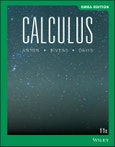Table of Contents
1 Limits and Continuity 1
1.1 Limits (An Intuitive Approach) 1
1.2 Computing Limits 13
1.3 Limits at Infinity; End Behavior of a Function 22
1.4 Limits (Discussed More Rigorously) 31
1.5 Continuity 40
1.6 Continuity of Trigonometric Functions 51
2 The Derivative 59
2.1 Tangent Lines and Rates of Change 59
2.2 The Derivative Function 69
2.3 Introduction to Techniques of Differentiation 80
2.4 The Product and Quotient Rules 88
2.5 Derivatives of Trigonometric Functions 93
2.6 The Chain Rule 98
2.7 Implicit Differentiation 105
2.8 Related Rates 112
2.9 Local Linear Approximation; Differentials 119
3 The Derivative in Graphing and Applications 130
3.1 Analysis of Functions I: Increase, Decrease, and Concavity 130
3.2 Analysis of Functions II: Relative Extrema; Graphing Polynomials 139
3.3 Analysis of Functions III: Rational Functions, Cusps, and Vertical Tangents 148
3.4 Absolute Maxima and Minima 157
3.5 Applied Maximum and Minimum Problems 164
3.6 Rectilinear Motion 177
3.7 Newton’s Method 185
3.8 Rolle’s Theorem; Mean-Value Theorem 191
4 Integration 203
4.1 An Overview of the Area Problem 203
4.2 The Indefinite Integral 208
4.3 Integration by Substitution 217
4.4 The Definition of Area as a Limit; Sigma Notation 223
4.5 The Definite Integral 233
4.6 The Fundamental Theorem of Calculus 242
4.7 Rectilinear Motion Revisited Using Integration 253
4.8 Average Value of a Function and its Applications 262
4.9 Evaluating Definite Integrals by Substitution 266
5 Applications of the Definite Integral in Geometry, Science, and Engineering 277
5.1 Area Between Two Curves 277
5.2 Volumes by Slicing; Disks and Washers 284
5.3 Volumes by Cylindrical Shells 294
5.4 Length of a Plane Curve 300
5.5 Area of a Surface of Revolution 306
5.6 Work 311
5.7 Moments, Centers of Gravity, and Centroids 319
5.8 Fluid Pressure and Force 328
6 Exponential, Logarithmic, and Inverse Trigonometric Functions 336
6.1 Exponential and Logarithmic Functions 336
6.2 Derivatives and Integrals Involving Logarithmic Functions 347
6.3 Derivatives of Inverse Functions; Derivatives and Integrals Involving Exponential Functions 353
6.4 Graphs and Applications Involving Logarithmic and Exponential Functions 360
6.5 L’Hôpital’s Rule; Indeterminate Forms 367
6.6 Logarithmic and Other Functions Defined by Integrals 376
6.7 Derivatives and Integrals Involving Inverse Trigonometric Functions 387
6.8 Hyperbolic Functions and Hanging Cables 398
7 Principles of Integral Evaluation 412
7.1 An Overview of Integration Methods 412
7.2 Integration by Parts 415
7.3 Integrating Trigonometric Functions 423
7.4 Trigonometric Substitutions 431
7.5 Integrating Rational Functions by Partial Fractions 437
7.6 Using Computer Algebra Systems and Tables of Integrals 445
7.7 Numerical Integration; Simpson’s Rule 454
7.8 Improper Integrals 467
8 Mathematical Modeling with Differential Equations 481
8.1 Modeling with Differential Equations 481
8.2 Separation of Variables 487
8.3 Slope Fields; Euler’s Method 498
8.4 First-Order Differential Equations and Applications 504
9 Infinite Series 514
9.1 Sequences 514
9.2 Monotone Sequences 524
9.3 Infinite Series 531
9.4 Convergence Tests 539
9.5 The Comparison, Ratio, and Root Tests 547
9.6 Alternating Series; Absolute and Conditional Convergence 553
9.7 Maclaurin and Taylor Polynomials 563
9.8 Maclaurin and Taylor Series; Power Series 573
9.9 Convergence of Taylor Series 582
9.10 Differentiating and Integrating Power Series; Modeling with Taylor Series 591
10 Parametric and Polar Curves; Conic Sections 605
10.1 Parametric Equations; Tangent Lines and Arc Length for Parametric Curves 605
10.2 Polar Coordinates 617
10.3 Tangent Lines, Arc Length, and Area for Polar Curves 630
10.4 Conic Sections 639
10.5 Rotation of Axes; Second-Degree Equations 656
10.6 Conic Sections in Polar Coordinates 661
11 Three-Dimensional Space; Vectors 674
11.1 Rectangular Coordinates in 3-Space; Spheres; Cylindrical Surfaces 674
11.2 Vectors 680
11.3 Dot Product; Projections 691
11.4 Cross Product 700
11.5 Parametric Equations of Lines 710
11.6 Planes in 3-Space 717
11.7 Quadric Surfaces 725
11.8 Cylindrical and Spherical Coordinates 735
12 Vector-Valued Functions 744
12.1 Introduction to Vector-Valued Functions 744
12.2 Calculus of Vector-Valued Functions 750
12.3 Change of Parameter; Arc Length 759
12.4 Unit Tangent, Normal, and Binormal Vectors 768
12.5 Curvature 773
12.6 Motion Along a Curve 781
12.7 Kepler’s Laws of Planetary Motion 794
13 Partial Derivatives 805
13.1 Functions of Two or More Variables 805
13.2 Limits and Continuity 815
13.3 Partial Derivatives 824
13.4 Differentiability, Differentials, and Local Linearity 837
13.5 The Chain Rule 845
13.6 Directional Derivatives and Gradients 855
13.7 Tangent Planes and Normal Vectors 866
13.8 Maxima and Minima of Functions of Two Variables 872
13.9 Lagrange Multipliers 883
14 Multiple Integrals 894
14.1 Double Integrals 894
14.2 Double Integrals over Nonrectangular Regions 902
14.3 Double Integrals in Polar Coordinates 910
14.4 Surface Area; Parametric Surfaces 918
14.5 Triple Integrals 930
14.6 Triple Integrals in Cylindrical and Spherical Coordinates 938
14.7 Change of Variables in Multiple Integrals; Jacobians 947
14.8 Centers of Gravity Using Multiple Integrals 959
15 Topics in Vector Calculus 971
15.1 Vector Fields 971
15.2 Line Integrals 980
15.3 Independence of Path; Conservative Vector Fields 995
15.4 Green’s Theorem 1005
15.5 Surface Integrals 1013
15.6 Applications of Surface Integrals; Flux 1021
15.7 The Divergence Theorem 1030
15.
Robotics - Chapter 2
Railroad Design - Chapter 7
Iteration and Dynamical Systems - Chapter 9
Comet Collision - Chapter 10
Blammo the Human Cannonball - Chapter 12
Hurricane Modeling - Chapter 15








